Coxeter notation
C1v |
C2v |
C3v |
C4v |
C5v |
C6v |
|---|---|---|---|---|---|
 Order 2 |
 Order 4 |
 Order 6 |
 Order 8 |
 Order 10 |
 Order 12 |
[2]=[2,1] D1h |
[2,2] D2h |
[2,3] D3h |
[2,4] D4h |
[2,5] D5h |
[2,6] D6h |
 Order 4 |
 Order 8 |
 Order 12 |
 Order 16 |
 Order 20 |
 Order 24 |
 Order 24 |
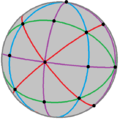 Order 48 |
 Order 120 | |||
| Coxeter notation expresses Coxeter groups as a list of branch orders of a Coxeter diagram, like the polyhedral groups, | |||||
In geometry, Coxeter notation (also Coxeter symbol) is a system of classifying symmetry groups, describing the angles between with fundamental reflections of a Coxeter group in a bracketed notation, with modifiers to indicate certain subgroups. The notation is named after H. S. M. Coxeter, and has been more comprehensively defined by Norman Johnson.
Reflectional groups
For Coxeter groups defined by pure reflections, there is a direct correspondence between the bracket notation and Coxeter-Dynkin diagram. The numbers in the bracket notation represent the mirror reflection orders in the branches of the Coxeter diagram. It uses the same simplification, suppressing 2s between orthogonal mirrors.
The Coxeter notation is simplified with exponents to represent the number of branches in a row for linear diagram. So the An group is represented by [3n-1], to imply n nodes connected by n-1 order-3 branches. Example A2 = [3,3] = [32] or [31,1] represents diagrams ![]()
![]()
![]()
![]()
![]() or
or ![]()
![]()
![]() .
.
Coxeter initially represented bifurcating diagrams with vertical positioning of numbers, but later abbreviated with an exponent notation, like [3p,q,r], starting with [31,1,1] = ![]()
![]()
![]()
![]()
![]() as D4. Coxeter allowed for zeros as special cases to fit the An family, like A3 = [3,3,3,3] = [34,0,0] = [33,1,0] = [32,2,0], like
as D4. Coxeter allowed for zeros as special cases to fit the An family, like A3 = [3,3,3,3] = [34,0,0] = [33,1,0] = [32,2,0], like ![]()
![]()
![]()
![]()
![]()
![]()
![]()
![]()
![]() =
= ![]()
![]()
![]()
![]()
![]()
![]()
![]() =
= ![]()
![]()
![]()
![]()
![]() .
.
Coxeter groups formed by cyclic diagrams are represented by parenthesese inside of brackets, like [(p,q,r)] = ![]() for the triangle group (p q r). If the branch orders are equal, they can be grouped as an exponent as the length the cycle in brackets, like [(3,3,3,3)] = [3[4]], representing Coxeter diagram
for the triangle group (p q r). If the branch orders are equal, they can be grouped as an exponent as the length the cycle in brackets, like [(3,3,3,3)] = [3[4]], representing Coxeter diagram ![]()
![]()
![]()
![]()
![]() or
or ![]()
![]()
![]() .
. ![]()
![]()
![]()
![]()
![]() can be represented as [3,(3,3,3)] or [3,3[3]].
can be represented as [3,(3,3,3)] or [3,3[3]].
More complicated looping diagrams can also be expressed with care. The paracompact Coxeter group ![]()
![]()
![]()
![]()
![]() can be represented by Coxeter notation [(3,3,(3),3,3)], with nested/overlapping parentheses showing two adjacent [(3,3,3)] loops, and is also represented more compactly as [3[ ]×[ ]], representing the rhombic symmetry of the Coxeter diagram. The paracompact complete graph diagram
can be represented by Coxeter notation [(3,3,(3),3,3)], with nested/overlapping parentheses showing two adjacent [(3,3,3)] loops, and is also represented more compactly as [3[ ]×[ ]], representing the rhombic symmetry of the Coxeter diagram. The paracompact complete graph diagram ![]() or
or ![]()
![]()
![]() , is represented as [3[3,3]] with the superscript [3,3] as the symmetry of its regular tetrahedron coxeter diagram.
, is represented as [3[3,3]] with the superscript [3,3] as the symmetry of its regular tetrahedron coxeter diagram.
The Coxeter diagram usually leaves order-2 branches undrawn, but the bracket notation includes an explicit 2 to connect the subgraphs. So the Coxeter diagram ![]()
![]()
![]()
![]()
![]()
![]()
![]() = A2×A2 = 2A2 can be represented by [3]×[3] = [3]2 = [3,2,3].
= A2×A2 = 2A2 can be represented by [3]×[3] = [3]2 = [3,2,3].
|
|
|
For the affine and hyperbolic groups, the subscript is one less than the number of nodes in each case, since each of these groups was obtained by adding a node to a finite group's diagram.
Subgroups
Coxeter's notation represents rotational/translational symmetry by adding a + superscript operator outside the brackets which cuts the order of the group in half (called index 2 subgroup). This is called a direct subgroup because what remains are only direct isometries without reflective symmetry.
+ operators can also be applied inside of the brackets, and creates "semidirect" subgroups that include both reflective and nonreflective generators. Semidirect subgroups can only apply to Coxeter group subgroups that have even order branches next to it. Elements by parentheses inside of a Coxeter group can be give a + superscript operator, having the effect of dividing adjacent ordered branches into half order, thus is usually only applied with even numbers. For example [4,3+] (![]()
![]()
![]()
![]()
![]() ) and [4,(3,3)+] (
) and [4,(3,3)+] (![]()
![]()
![]()
![]()
![]()
![]()
![]() ). The subgroup index is 2n for n + operators.
). The subgroup index is 2n for n + operators.
Groups without neighboring + elements can be seen in ringed nodes Coxeter-Dynkin diagram for uniform polytopes and honeycomb are related to hole nodes around the + elements, empty circles with the alternated nodes removed. So the snub cube, ![]()
![]()
![]()
![]()
![]() has symmetry [4,3]+ (
has symmetry [4,3]+ (![]()
![]()
![]()
![]()
![]() ), and the snub tetrahedron,
), and the snub tetrahedron, ![]()
![]()
![]()
![]()
![]() has symmetry [4,3+] (
has symmetry [4,3+] (![]()
![]()
![]()
![]()
![]() ), and a demicube, h{4,3} = {3,3} (
), and a demicube, h{4,3} = {3,3} (![]()
![]()
![]()
![]()
![]() or
or ![]()
![]()
![]() =
= ![]()
![]()
![]()
![]()
![]() ) has symmetry [1+,4,3] = [3,3] (
) has symmetry [1+,4,3] = [3,3] (![]()
![]()
![]()
![]()
![]() or
or ![]()
![]()
![]()
![]()
![]() =
= ![]()
![]()
![]() =
= ![]()
![]()
![]()
![]()
![]() ).
).
Halving subgroups
 |
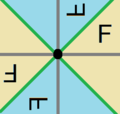 | |
[ 1,4, 1] = [4] |
[1+,4, 1]=[2]=[ ]×[ ] | |
 |
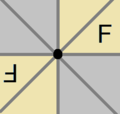 | |
[ 1,4,1+]=[2]=[ ]×[ ] |
[1+,4,1+] = [2]+ | |
Johnson extends the + operator to work with a placeholder 1 nodes, which removes mirrors, doubling the size of the fundamental domain and cuts the group order in half. In general this operation only applies to mirrors bounded by all even-order branches. The 1 represents a mirror so [2p] can be seen as [2p,1], [1,2p], or [1,2p,1], like diagram ![]()
![]()
![]()
![]() or
or ![]()
![]()
![]()
![]() , with 2 mirrors related by an order-2p dihedral angle. The effect of a mirror removal is to duplicate connecting nodes, which can be seen in the Coxeter diagrams:
, with 2 mirrors related by an order-2p dihedral angle. The effect of a mirror removal is to duplicate connecting nodes, which can be seen in the Coxeter diagrams: ![]()
![]()
![]()
![]() =
= ![]()
![]() , or in bracket notation:[1+,2p, 1] = [1,p,1] = [p].
, or in bracket notation:[1+,2p, 1] = [1,p,1] = [p].
Each of these mirrors can be removed so h[2p] = [1+,2p,1] = [1,2p,1+] = [p], a reflective subgroup index 2. This can be shown in a Coxeter diagram by adding a + symbol above the node: ![]()
![]()
![]()
![]() =
= ![]()
![]()
![]()
![]() =
= ![]()
![]() .
.
If both mirrors are removed, a quarter subgroup is generated, with the branch order becoming a gyration point of half the order:
- q[2p] = [1+,2p,1+] = [p]+, a rotational subgroup of index 4.



 =
= 


 =
= 


 =
= 
 .
.
For example (with p=2): [4,1+] = [1+,4] = [2] = [ ]×[ ], order 4. [1+,4,1+] = [2]+, order 2.
The opposite to halving is doubling which adds a mirror, bisecting a fundamental domain, and doubling the group order.
- p = [2p]
Halving operations apply for higher rank groups, like h[4,3] = [1+,4,3] = [3,3], removing half the mirrors at the 4-branch. The effect of a mirror removal is to duplicate all connecting nodes, which can be seen in the Coxeter diagrams: ![]()
![]()
![]()
![]()
![]()
![]() =
= ![]()
![]()
![]()
![]() , h[2p,3] = [1+,2p,3] = [(p,3,3)].
, h[2p,3] = [1+,2p,3] = [(p,3,3)].
Doubling by adding a mirror also applies in reversing the halving operation: 3,3 = [4,3], or more generally (q,q,p) = [2p,q].
| Tetrahedral symmetry | Octahedral symmetry |
|---|---|
 Td, [3,3] = [1+,4,3] (Order 24) |
 Oh, [4,3] = 3,3 (Order 48) |
Radical subgroups

Johnson also added an asterisk or star * operator, that acts similar to the + operator, but removes rotational symmetry. The index of the radical subgroup is the order of the removed element. For example [4,3*] ≅ [2,2]. The removed [3] subgroup is order 6 so [2,2] is an index 6 subgroup of [4,3].
The radical subgroups represent the inverse operation to an extended symmetry operation. For example [4,3*] ≅ [2,2], and in reverse [2,2] can be extended as [3[2,2]] ≅ [4,3]. The subgroups can be expressed as a Coxeter diagram: ![]()
![]()
![]()
![]()
![]() ≅
≅ ![]()
![]()
![]()
![]()
![]() . The removed node (mirror) causes adjacent mirror virtual mirrors to become real mirrors.
. The removed node (mirror) causes adjacent mirror virtual mirrors to become real mirrors.
If [4,3] has generators {0,1,2}, [4,3+], index 2, has generators {0,12}; [1+,4,3], index 2 has generators {010,1,2}; while radical subgroup [4,3*], index 6, has generators {01210, 2, (012)3}; and finally [1+,4,3*], index 12 has generators {0(12)20, (012)201}.
Trionic subgroups

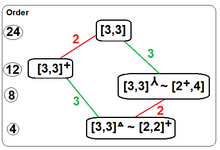
Johnson identified two specific subgroups of [3,3], first an index 3 subgroup [3,3]⅄ ≅ [2+,4], with [3,3] (![]()
![]()
![]()
![]()
![]() =
= ![]()
![]()
![]() ) generators {0,1,2}. It can also be written as [(3,3,2⅄)] (
) generators {0,1,2}. It can also be written as [(3,3,2⅄)] (![]()
![]()
![]()
![]()
![]() ⅄) as a reminder of its generators {02,1}. This symmetry reduction is the relationship between the regular tetrahedron and the tetragonal disphenoid, represent a stretching of a tetrahedron perpendicular to two opposite edges.
⅄) as a reminder of its generators {02,1}. This symmetry reduction is the relationship between the regular tetrahedron and the tetragonal disphenoid, represent a stretching of a tetrahedron perpendicular to two opposite edges.
Secondly he identifies a related index 6 subgroup [3,3]Δ or [(3,3,2⅄)]+, index 3 from [3,3]+ ≅ [2,2]+, with generators {02,1021}, from [3,3] and its generators {0,1,2}.
These subgroups also apply within larger Coxeter groups with [3,3] subgroup with neighboring branches all even order.
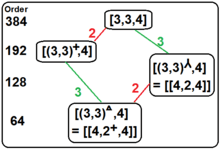
For example [(3,3)+,4], [(3,3)⅄,4], and [(3,3)Δ,4] are subgroups of [3,3,4], index 2, 3 and 6 respectively. The generators of [(3,3)⅄,4] ≅ 4,2,4 ≅ [8,2+,8], order 128, are {02,1,3} from [3,3,4] generators {0,1,2,3}. And [(3,3)Δ,4] ≅ [[4,2<sup>+</sup>,4]], order 64, has generators {02,1021,3}.
Also related [31,1,1] = [3,3,4,1+] has trionic subgroups: [31,1,1]⅄ = [(3,3)⅄,4,1+], order 64, and [31,1,1]Δ = [(3,3)Δ,4,1+] ≅ [[4,2<sup>+</sup>,4]]+, order 32.
Central inversion
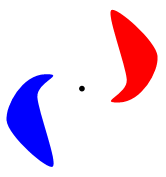
A central inversion, order 2, is operationally differently by dimension. The group [ ]n = [2n-1] represents n orthogonal mirrors in n-dimensional space, or an n-flat subspace of a higher dimensional space. The mirrors of the group [2n-1] are numbered 0..n-1. The order of the mirrors doesn't matter in the case of an inversion.
From that basis, the central inversion has a generator as the product of all the orthogonal mirrors. In Coxeter notation this inversion group is expressed by adding an alternation + to each 2 branch. The alternation symmetry is marked on Coxeter diagram nodes as open nodes.
A Coxeter-Dynkin diagram can be marked up with explicit 2 branches defining a linear sequence of mirrors, open-nodes, and shared double-open nodes to show the chaining of the reflection generators.
For example, [2+,2] and [2,2+] are subgroups index 2 of [2,2], ![]()
![]()
![]()
![]()
![]() , and are represented as
, and are represented as ![]()
![]()
![]()
![]()
![]() and
and ![]()
![]()
![]()
![]()
![]() with generators {01,2} and {0,12} respectively. Their common subgroup index 4 is [2+,2+], and is represented by
with generators {01,2} and {0,12} respectively. Their common subgroup index 4 is [2+,2+], and is represented by ![]()
![]()
![]()
![]()
![]() , with the double-open
, with the double-open ![]() marking a shared node in the two alternations, and a single rotoreflection generator {012}.
marking a shared node in the two alternations, and a single rotoreflection generator {012}.
| Dimension | Coxeter notation | Order | Coxeter diagram | Operation | Generator |
|---|---|---|---|---|---|
| 2 | [2]+ | 2 | 180° rotation, C2 | {01} | |
| 3 | [2+,2+] | 2 | rotoreflection, Ci or S2 | {012} | |
| 4 | [2+,2+,2+] | 2 | double rotation | {0123} | |
| 5 | [2+,2+,2+,2+] | 2 | double rotary reflection | {01234} | |
| 6 | [2+,2+,2+,2+,2+] | 2 | triple rotation | {012345} | |
| 7 | [2+,2+,2+,2+,2+,2+] | 2 | triple rotary reflection | {0123456} |
Rotations and rotary reflections
Rotations and rotary reflections are constructed by a single single-generator product of all the reflections of a prismatic group, [2p]×[2q]×... When gcd(p,q,..)=1, they are isomorphic to the abstract cyclic group Zn, of order n=2pq.
The 4-dimensional double rotations, [2p+,2+,2q+], which include a central group, and are expressed by Conway as ±[Cp×Cq], order 2pq/gcd(p,q).[1]
| Dimension | Coxeter notation | Order | Coxeter diagram | Operation | Generator | Direct subgroup |
|---|---|---|---|---|---|---|
| 2 | [p]+ | p | Rotation | {01} | [p]+ | |
| 3 | [2p+,2+] | 2p | rotary reflection | {012} | ||
| 4 | [2p+,2+,2+] | double rotation | {0123} | |||
| 5 | [2p+,2+,2+,2+] | double rotary reflection | {01234} | |||
| 6 | [2p+,2+,2+,2+,2+] | triple rotation | {012345} | |||
| 7 | [2p+,2+,2+,2+,2+,2+] | triple rotary reflection | {0123456} | |||
| 4 | [2p+,2+,2q+] | 2pq | double rotation | {0123} | [p+,2,q+] | |
| 5 | [2p+,2+,2q+,2+] | double rotary reflection | {01234} | |||
| 6 | [2p+,2+,2q+,2+,2+] | triple rotation | {012345} | |||
| 7 | [2p+,2+,2q+,2+,2+,2+] | triple rotary reflection | {0123456} | |||
| 6 | [2p+,2+,2q+,2+,2r+] | 2pqr | triple rotation | {012345} | [p+,2,q+,2,r+] | |
| 7 | [2p+,2+,2q+,2+,2r+,2+] | triple rotary reflection | {0123456} |
Commutator subgroups
Simple groups with only odd-order branch elements have only a single rotational/translational subgroup of order 2, which is also the commutator subgroup, examples [3,3]+, [3,5]+, [3,3,3]+, [3,3,5]+. For other Coxeter groups with even-order branches, the commutator subgroup has index 2c, where c is the number of disconnected subgraphs when all the even-order branches are removed.[2] For example, [4,4] has three independent nodes in the Coxeter diagram when the 4s are removed, so its commutator subgroup is index 23, and can have different representations, all with three + operators: [4+,4+]+, [1+,4,1+,4,1+], [1+,4,4,1+]+, or [(4+,4+,2+)]. A general notation can be used with +c as a group exponent, like [4,4]+3.
Example subgroups
Rank 2 example subgroups
Dihedral symmetry groups with even-orders have a number of subgroups. This example shows two generator mirrors of [4] in red and green, and looks at all subgroups by halfing, rank-reduction, and their direct subgroups. The group [4], ![]()
![]()
![]() has two mirror generators 0, and 1. Each generate two virtual mirrors 101 and 010 by reflection across the other.
has two mirror generators 0, and 1. Each generate two virtual mirrors 101 and 010 by reflection across the other.
| Index | 1 | 2 (half) | 4 (Rank-reduction) | ||
|---|---|---|---|---|---|
| Diagram |  |
 |
 |
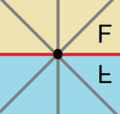 |
 |
| Coxeter |
[1,4,1] = [4] |
[1+,4,1] = [1+,4] = [2] |
[1,4,1+] = [4,1+] = [2] |
[1] = [ ] |
[1] = [ ] |
| Generators | {0,1} | {101,1} | {0,010} | {0} | {1} |
| Direct subgroups | |||||
| Index | 2 | 4 | 8 | ||
| Diagram |  |
 |
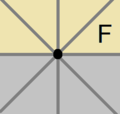 | ||
| Coxeter | [4]+ |
[4]+2 = [1+,4,1+] = [2]+ |
[ ]+ | ||
| Generators | {01} | {(01)2} | {02} = {12} = {(01)4} = { } | ||
Rank 3 Euclidean example subgroups
The [4,4] group has 15 small index subgroups. This table shows them all, with a yellow fundamental domain for pure reflective groups, and alternating white and blue domains which are paired up to make rotational domains. Cyan, red, and green mirror lines correspond to the same colored nodes in the Coxeter diagram. Subgroup generators can be expressed as products of the original 3 mirrors of the fundamental domain, {0,1,2}, corresponding to the 3 nodes of the Coxeter diagram, ![]()
![]()
![]()
![]()
![]() . A product of two intersecting reflection lines makes a rotation, like {012}, {12}, or {02}. Removing a mirror causes two copies of neighboring mirrors, across the removed mirror, like {010}, and {212}. Two rotations in series cut the rotation order in half, like {0101} or {(01)2}, {1212} or {(02)2}. A product of all three mirrors creates a transreflection, like {012} or {120}.
. A product of two intersecting reflection lines makes a rotation, like {012}, {12}, or {02}. Removing a mirror causes two copies of neighboring mirrors, across the removed mirror, like {010}, and {212}. Two rotations in series cut the rotation order in half, like {0101} or {(01)2}, {1212} or {(02)2}. A product of all three mirrors creates a transreflection, like {012} or {120}.
| Index | 1 | 2 | 4 | |||
|---|---|---|---|---|---|---|
| Diagram | 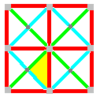 |
 |
 |
 |
 |
 |
| Coxeter |
[1,4,1,4,1] = [4,4] |
[1+,4,4] |
[4,4,1+] |
[4,1+,4] |
[1+,4,4,1+] |
[4+,4+] |
| Generators | {0,1,2} | {010,1,2} | {0,1,212} | {0,101,121,2} | {010,1,212,20102} | {(01)2,(12)2,012,120} |
| Orbifold | *442 | *2222 | 22× | |||
| Semidirect subgroups | ||||||
| Index | 2 | 4 | ||||
| Diagram | 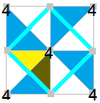 |
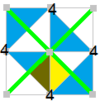 |
 |
 |
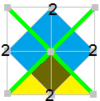 | |
| Coxeter | [4,4+] |
[4+,4] |
[(4,4,2+)] |
[4,1+,4,1+] |
[1+,4,1+,4] | |
| Generators | {0,12} | {01,2} | {02,1,212} | {0,101,(12)2} | {(01)2,121,2} | |
| Orbifold | 4*2 | 2*22 | ||||
| Direct subgroups | ||||||
| Index | 2 | 4 | 8 | |||
| Diagram | 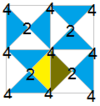 |
 |
 |
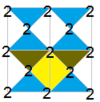 |
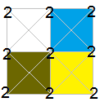 | |
| Coxeter | [4,4]+ |
[4,4+]+ |
[4+,4]+ |
[(4,4,2+)]+ |
[4,4]+3 = [(4+,4+,2+)] = [1+,4,1+,4,1+] = [4+,4+]+ | |
| Generators | {01,12} | {(01)2,12} | {01,(12)2} | {02,(01)2,(12)2} | {(01)2,(12)2,2(01)22} | |
| Orbifold | 442 | 2222 | ||||
| Radical subgroups | ||||||
| Index | 8 | 16 | ||||
| Diagram |  |
 |
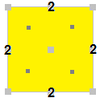 |
 | ||
| Coxeter | [4,4*] |
[4*,4] |
[4,4*]+ |
[4*,4]+ | ||
| Orbifold | *2222 | 2222 | ||||
Hyperbolic example subgroups
The same set of 15 small subgroups exists on all triangle groups with even order elements, like [6,4] in the hyperbolic plane:
| Index | 1 | 2 | 4 | |||||
|---|---|---|---|---|---|---|---|---|
| Diagram | 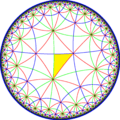 |
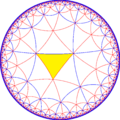 |
 |
 |
 |
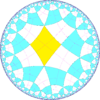 | ||
| Coxeter |
[1,6,1,4,1] = [6,4] |
[1+,6,4] |
[6,4,1+] |
[6,1+,4] |
[1+,6,4,1+] |
[6+,4+] | ||
| Generators | {0,1,2} | {010,1,2} | {0,1,212} | {0,101,121,2} | {010,1,212,20102} | {(01)2,(12)2,012} | ||
| Orbifold | *642 | *443 | *662 | *3222 | *3232 | 32× | ||
| Semidirect subgroups | ||||||||
| Diagram |  |
 |
 |
 |
 | |||
| Coxeter | [6,4+] |
[6+,4] |
[(6,4,2+)] |
[6,1+,4,1+] = |
[1+,6,1+,4] = | |||
| Generators | {0,12} | {01,2} | {02,1,212} | {0,101,(12)2} | {(01)2,121,2} | |||
| Orbifold | 4*3 | 6*2 | 2*32 | 2*33 | 3*22 | |||
| Direct subgroups | ||||||||
| Index | 2 | 4 | 8 | |||||
| Diagram | 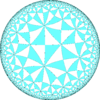 |
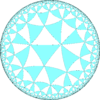 |
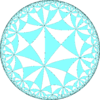 |
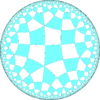 |
 | |||
| Coxeter | [6,4]+ |
[6,4+]+ |
[6+,4]+ |
[(6,4,2+)]+ |
[6+,4+]+ = [1+,6,1+,4,1+] = | |||
| Generators | {01,12} | {(01)2,12} | {01,(12)2} | {02,(01)2,(12)2} | {(01)2,(12)2,201012} | |||
| Orbifold | 642 | 443 | 662 | 3222 | 3232 | |||
| Radical subgroups | ||||||||
| Index | 8 | 12 | 16 | 24 | ||||
| Diagram |  |
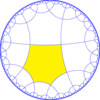 |
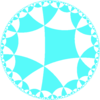 |
 | ||||
| Coxeter (orbifold) |
[6,4*] (*3333) |
[6*,4] (*222222) |
[6,4*]+ (3333) |
[6*,4]+ (222222) | ||||
Extended symmetry
| ||||||||||||||||||||||||||||||||||
In the Euclidean plane, the  , [3[3]] Coxeter group can be extended in two ways into the , [3[3]] Coxeter group can be extended in two ways into the  , [6,3] Coxeter group and relates uniform tilings as ringed diagrams. , [6,3] Coxeter group and relates uniform tilings as ringed diagrams. |
Coxeter's notation includes double square bracket notation, X to express automorphic symmetry within a Coxeter diagram. Johnson added alternative of angled-bracket <[X]> option as equivalent to square brackets for doubling to distinguish diagram symmetry through the nodes versus through the branches. Johnson also added a prefix symmetry modifier [Y[X]], where Y can either represent symmetry of the Coxeter diagram of [X], or symmetry of the fundamental domain of [X].
For example in 3D these equivalent rectangle and rhombic geometry diagrams of  :
: ![]()
![]()
![]()
![]() and
and ![]()
![]()
![]()
![]()
![]() , the first doubled with square brackets, [[3[4]]] or twice doubled as [2[3[4]]], with [2], order 4 higher symmetry. To differentiate the second, angled brackets are used for doubling, <[3[4]]> and twice doubled as <2[3[4]]>, also with a different [2], order 4 symmetry. Finally a full symmetry where all 4 nodes are equivalent can be represented by [4[3[4]]], with the order 8, [4] symmetry of the square. But by considering the tetragonal disphenoid fundamental domain the [4] extended symmetry of the square graph can be marked more explicitly as [(2+,4)[3[4]]] or [2+,4[3[4]]].
, the first doubled with square brackets, [[3[4]]] or twice doubled as [2[3[4]]], with [2], order 4 higher symmetry. To differentiate the second, angled brackets are used for doubling, <[3[4]]> and twice doubled as <2[3[4]]>, also with a different [2], order 4 symmetry. Finally a full symmetry where all 4 nodes are equivalent can be represented by [4[3[4]]], with the order 8, [4] symmetry of the square. But by considering the tetragonal disphenoid fundamental domain the [4] extended symmetry of the square graph can be marked more explicitly as [(2+,4)[3[4]]] or [2+,4[3[4]]].
Further symmetry exists in the cyclic  and branching
and branching  ,
,  , and
, and  diagrams.
diagrams.  has order 2n symmetry of a regular n-gon, {n}, and is represented by [n[3[n]]].
has order 2n symmetry of a regular n-gon, {n}, and is represented by [n[3[n]]].  and
and  are represented by [3[31,1,1]] = [3,4,3] and [3[32,2,2]] respectively while
are represented by [3[31,1,1]] = [3,4,3] and [3[32,2,2]] respectively while  by [(3,3)[31,1,1,1]] = [3,3,4,3], with the diagram containing the order 24 symmetry of the regular tetrahedron, {3,3}. The paracompact hyperbolic group
by [(3,3)[31,1,1,1]] = [3,3,4,3], with the diagram containing the order 24 symmetry of the regular tetrahedron, {3,3}. The paracompact hyperbolic group  = [31,1,1,1,1],
= [31,1,1,1,1], ![]()
![]()
![]()
![]()
![]()
![]() , contains the symmetry of a 5-cell, {3,3,3}, and thus is represented by [(3,3,3)[31,1,1,1,1]] = [3,4,3,3,3].
, contains the symmetry of a 5-cell, {3,3,3}, and thus is represented by [(3,3,3)[31,1,1,1,1]] = [3,4,3,3,3].
An asterisk * superscript is effectively an inverse operation, creating radical subgroups removing connected of odd-ordered mirrors.[3]
Examples:
|
|
Looking at generators, the double symmmetry is seen as adding a new operator that maps symmetric positions in the Coxeter diagram, making some original generators redundant. For 3D space groups, and 4D point groups, Coxeter defines an index two subgroup of X, [[X]+], which he defines as the product of the original generators of [X] by the doubling generator. This looks similar to X+, which is the chiral subgroup of X. So for example the 3D space groups 4,3,4+ (I432, 211) and [[4,3,4]+] (Pm3n, 223) are distinct subgroups of 4,3,4 (Im3m, 229).
Computation with reflection matrices as symmetry generators
A Coxeter group, represented by Coxeter diagram ![]()
![]()
![]()
![]()
![]() , is given Coxeter notation [p,q] for the branch orders. Each node in the Coxeter diagram represents a mirror, by convention called ρi (and matrix Ri). The generators of this group [p,q] are reflections: ρ0, ρ1, and ρ2. Rotational subsymmetry is given as products of reflections: By convention, σ0,1 (and matrix S0,1) = ρ0ρ1 represents a rotation of angle π/p, and σ1,2 = ρ1ρ2 is a rotation of angle π/q, and σ0,2 = ρ0ρ2 represents a rotation of angle π/2.
, is given Coxeter notation [p,q] for the branch orders. Each node in the Coxeter diagram represents a mirror, by convention called ρi (and matrix Ri). The generators of this group [p,q] are reflections: ρ0, ρ1, and ρ2. Rotational subsymmetry is given as products of reflections: By convention, σ0,1 (and matrix S0,1) = ρ0ρ1 represents a rotation of angle π/p, and σ1,2 = ρ1ρ2 is a rotation of angle π/q, and σ0,2 = ρ0ρ2 represents a rotation of angle π/2.
[p,q]+ is an index 2 subgroup represented by two rotation generators, each a products of two reflections: σ0,1, σ1,2, and representing rotations of π/p, and π/q angles respectively.
If q is even, [p+,q] is another subgroup of index 2, represented by rotation generator σ0,1, and reflectional ρ2.
If both p and q are even, [p+,q+] is a subgroup of index 4 with two generators, constructed as a product of all three reflection matrices: By convention as: ψ0,1,2 and ψ1,2,0, which are rotary reflections, representing a reflection and rotation or reflection.
In the case of affine Coxeter groups like ![]()
![]()
![]()
![]()
![]() , or
, or ![]()
![]()
![]() , one mirror, usually the last, is translated off the origin. A translation generator τ0,1 (and matrix T0,1) is constructed as the product of two (or an even number of) reflections, including the affine reflection. A transreflection (reflection plus a translation) can be the product of an odd number of reflections φ0,1,2 (and matrix V0,1,2), like the index 4 subgroup
, one mirror, usually the last, is translated off the origin. A translation generator τ0,1 (and matrix T0,1) is constructed as the product of two (or an even number of) reflections, including the affine reflection. A transreflection (reflection plus a translation) can be the product of an odd number of reflections φ0,1,2 (and matrix V0,1,2), like the index 4 subgroup ![]()
![]()
![]()
![]()
![]() : [4+,4+] =
: [4+,4+] = ![]()
![]()
![]()
![]()
![]() .
.
Another composite generator, by convention as ζ (and matrix Z), represents the inversion, mapping a point to its inverse. For [4,3] and [5,3], ζ = (ρ0ρ1ρ2)h/2, where h is 6 and 10 respectively, the Coxeter number for each family. For 3D Coxeter group [p,q] (![]()
![]()
![]()
![]()
![]() ), this subgroup is a rotary reflection [2+,h+].
), this subgroup is a rotary reflection [2+,h+].
Example, in 2D, the Coxeter group [p] (![]()
![]()
![]() ) is represented by two reflection matrices R0 and R1, The cyclic symmetry [p]+ (
) is represented by two reflection matrices R0 and R1, The cyclic symmetry [p]+ (![]()
![]()
![]() ) is represented by rotation generator of matrix S0,1.
) is represented by rotation generator of matrix S0,1.
| R0 | R1 | S0,1=R0xR1 |
|---|---|---|
|
|
|
|
A simple example affine group is [4,4] (![]()
![]()
![]()
![]()
![]() ) (p4m), can be given by three reflection matrices, constructed as a reflection across the x axis (y=0), a diagonal (x=y), and the affine reflection across the line (x=1). [4,4]+ (
) (p4m), can be given by three reflection matrices, constructed as a reflection across the x axis (y=0), a diagonal (x=y), and the affine reflection across the line (x=1). [4,4]+ (![]()
![]()
![]()
![]()
![]() ) (p4) is generated by S0,1 S1,2, and S0,2. [4+,4+] (
) (p4) is generated by S0,1 S1,2, and S0,2. [4+,4+] (![]()
![]()
![]()
![]()
![]() ) (pgg) is generated by 2-fold rotation S0,2 and transreflection V0,1,2. [4+,4] (
) (pgg) is generated by 2-fold rotation S0,2 and transreflection V0,1,2. [4+,4] (![]()
![]()
![]()
![]()
![]() ) (p4g) is generated by S0,1 and R3. The group [(4,4,2+)] (
) (p4g) is generated by S0,1 and R3. The group [(4,4,2+)] (![]()
![]()
![]()
![]() ) (cmm), is generated by 2-fold rotation S1,3 and reflection R2.
) (cmm), is generated by 2-fold rotation S1,3 and reflection R2.
| R0 | R1 | R2 | S0,1 | S1,2 | S0,2 | V0,1,2 |
|---|---|---|---|---|---|---|
|
|
|
|
|
|
|
|
Coxeter groups are categorized by their rank, being the number of nodes in its Coxeter-Dynkin diagram. The structure of the groups are also given with their abstract group types: In this article, the abstract dihedral groups are represented as Dihn, and cyclic groups are represented by Zn, with Dih1=Z2.
Rank one groups
In one dimension, the bilateral group [ ] represents a single mirror symmetry, abstract Dih1 or Z2, symmetry order 2. It is represented as a Coxeter–Dynkin diagram with a single node, ![]() . The identity group is the direct subgroup [ ]+, Z1, symmetry order 1. The + superscript simply implies that alternate mirror reflections are ignored, leaving the identity group in this simplest case. Coxeter used a single open node to represent an alternation,
. The identity group is the direct subgroup [ ]+, Z1, symmetry order 1. The + superscript simply implies that alternate mirror reflections are ignored, leaving the identity group in this simplest case. Coxeter used a single open node to represent an alternation, ![]() .
.
| Group | Coxeter notation | Coxeter diagram | Order | Description |
|---|---|---|---|---|
| C1 | [ ]+ | 1 | Identity | |
| D1 | [ ] | 2 | Reflection group |
Rank two groups

In two dimensions, the rectangular group [2], abstract D12 or D2, also can be represented as a direct product [ ]×[ ], being the product of two bilateral groups, represents two orthogonal mirrors, with Coxeter diagram, ![]()
![]()
![]() , with order 4. The 2 in [2] comes from linearization of the orthogonal subgraphs in the Coxeter diagram, as
, with order 4. The 2 in [2] comes from linearization of the orthogonal subgraphs in the Coxeter diagram, as ![]()
![]()
![]() , with explicit branch order 2. The rhombic group, [2]+ (
, with explicit branch order 2. The rhombic group, [2]+ (![]()
![]()
![]() ), half of the rectangular group, the point reflection symmetry, Z2, order 2.
), half of the rectangular group, the point reflection symmetry, Z2, order 2.
Coxeter notation to allow a 1 place-holder for lower rank groups, so [1] is the same as [ ], and [1+] or [1]+ is the same as [ ]+ and Coxeter diagram ![]() .
.
The full p-gonal group [p], abstract dihedral group Dp, (nonabelian for p>2), of order 2p, is generated by two mirrors at angle π/p, represented by Coxeter diagram ![]()
![]()
![]() . The p-gonal subgroup [p]+, cyclic group Zp, of order p, generated by a rotation angle of π/p.
. The p-gonal subgroup [p]+, cyclic group Zp, of order p, generated by a rotation angle of π/p.
Coxeter notation uses double-bracking to represent an automorphic doubling of symmetry by adding a bisecting mirror to the fundamental domain. For example [[p]] adds a bisecting mirror to [p], and is isomorphic to [2p].
In the limit, going down to one dimensions, the full apeirogonal group is obtained when the angle goes to zero, so [∞], abstractly the infinite dihedral group D∞, represents two parallel mirrors and has a Coxeter diagram ![]()
![]()
![]() . The apeirogonal group [∞]+,
. The apeirogonal group [∞]+, ![]()
![]()
![]() , abstractly the infinite cyclic group Z∞, isomorphic to the additive group of the integers, is generated by a single nonzero translation.
, abstractly the infinite cyclic group Z∞, isomorphic to the additive group of the integers, is generated by a single nonzero translation.
In the hyperbolic plane, there is a full pseudogonal group [iπ/λ], and pseudogonal subgroup [iπ/λ]+, ![]()
![]()
![]() . These groups exist in regular infinite-sided polygons, with edge length λ. The mirrors are all orthogonal to a single line.
. These groups exist in regular infinite-sided polygons, with edge length λ. The mirrors are all orthogonal to a single line.
| Type | Finite | Affine | Hyperbolic | |||||
|---|---|---|---|---|---|---|---|---|
| Geometry |  |
 |
 |
 |
... |  |
 |
 |
| Coxeter | [ ] |
[2]=[ ]×[ ] |
[3] |
[4] |
[p] |
[∞] |
[∞] |
[iπ/λ] |
| Order | 2 | 4 | 6 | 8 | 2p | ∞ | ||
| Mirror lines are colored to correspond to Coxeter diagram nodes. Fundamental domains are alternately colored. | ||||||||
| Even images (direct) |
 |
 |
 |
 |
... |  |
 | |
| Odd images (inverted) |
 |
 |
 |
 |
 |
 | ||
| Coxeter | [ ]+ |
[2]+ |
[3]+ |
[4]+ |
[p]+ |
[∞]+ |
[∞]+ |
[iπ/λ]+ |
| Order | 1 | 2 | 3 | 4 | p | ∞ | ||
| Cyclic subgroups represent alternate reflections, all even (direct) images. | ||||||||
| Group | Intl | Orbifold | Coxeter | Coxeter diagram | Order | Description |
|---|---|---|---|---|---|---|
| Finite | ||||||
| Zn | n | n• | [n]+ | |
n | Cyclic: n-fold rotations. Abstract group Zn, the group of integers under addition modulo n. |
| Dn | nm | *n• | [n] | |
2n | Dihedral: cyclic with reflections. Abstract group Dihn, the dihedral group. |
| Affine | ||||||
| Z∞ | ∞ | ∞• | [∞]+ | |
∞ | Cyclic: apeirogonal group. Abstract group Z∞, the group of integers under addition. |
| Dih∞ | ∞m | *∞• | [∞] | |
∞ | Dihedral: parallel reflections. Abstract infinite dihedral group Dih∞. |
| Hyperbolic | ||||||
| Z∞ | [πi/λ]+ | |
∞ | pseudogonal group | ||
| Dih∞ | [πi/λ] | |
∞ | full pseudogonal group | ||
Rank three groups


In three dimensions, the full orthorhombic group [2,2], abtractly Z2×D2, order 8, represents three orthogonal mirrors, (also represented by Coxeter diagram as three separate dots ![]()
![]()
![]()
![]()
![]() ). It can also can be represented as a direct product [ ]×[ ]×[ ], but the [2,2] expression allows subgroups to be defined:
). It can also can be represented as a direct product [ ]×[ ]×[ ], but the [2,2] expression allows subgroups to be defined:
First there is a "semidirect" subgroup, the orthorhombic group, [2,2+] (![]()
![]()
![]()
![]()
![]() ), abstractly D1×Z2=Z2×Z2, of order 4. When the + superscript is given inside of the brackets, it means reflections generated only from the adjacent mirrors (as defined by the Coxeter diagram,
), abstractly D1×Z2=Z2×Z2, of order 4. When the + superscript is given inside of the brackets, it means reflections generated only from the adjacent mirrors (as defined by the Coxeter diagram, ![]()
![]()
![]()
![]()
![]() ) are alternated. In general, the branch orders neighboring the + node must be even. In this case [2,2+] and [2+,2] represent two isomorphic subgroups that are geometrically distinct. The other subgroups are the pararhombic group [2,2]+ (
) are alternated. In general, the branch orders neighboring the + node must be even. In this case [2,2+] and [2+,2] represent two isomorphic subgroups that are geometrically distinct. The other subgroups are the pararhombic group [2,2]+ (![]()
![]()
![]()
![]()
![]() ), also order 4, and finally the central group [2+,2+] (
), also order 4, and finally the central group [2+,2+] (![]()
![]()
![]()
![]()
![]() ) of order 2.
) of order 2.
Next there is the full ortho-p-gonal group, [2,p] (![]()
![]()
![]()
![]()
![]() ), abstractly D1×Dp=Z2×Dp, of order 4p, representing two mirrors at a dihedral angle π/p, and both are orthogonal to a third mirror. It is also represented by Coxeter diagram as
), abstractly D1×Dp=Z2×Dp, of order 4p, representing two mirrors at a dihedral angle π/p, and both are orthogonal to a third mirror. It is also represented by Coxeter diagram as ![]()
![]()
![]()
![]()
![]() .
.
The direct subgroup is called the para-p-gonal group, [2,p]+ (![]()
![]()
![]()
![]()
![]() ), abstractly Dp, of order 2p, and another subgroup is [2,p+] (
), abstractly Dp, of order 2p, and another subgroup is [2,p+] (![]()
![]()
![]()
![]()
![]() ) abstractly Z2×Zp, also of order 2p.
) abstractly Z2×Zp, also of order 2p.
The full gyro-p-gonal group, [2+,2p] (![]()
![]()
![]()
![]()
![]()
![]() ), abstractly D2p, of order 4p. The gyro-p-gonal group, [2+,2p+] (
), abstractly D2p, of order 4p. The gyro-p-gonal group, [2+,2p+] (![]()
![]()
![]()
![]()
![]()
![]() ), abstractly Z2p, of order 2p is a subgroup of both [2+,2p] and [2,2p+].
), abstractly Z2p, of order 2p is a subgroup of both [2+,2p] and [2,2p+].
The polyhedral groups are based on the symmetry of platonic solids, the tetrahedron, octahedron, cube, icosahedron, and dodecahedron, with Schläfli symbols {3,3}, {3,4}, {4,3}, {3,5}, and {5,3} respectively. The Coxeter groups for these are called in Coxeter's bracket notation [3,3], [3,4], [3,5] called full tetrahedral symmetry, octahedral symmetry, and icosahedral symmetry, with orders of 24, 48, and 120. The front-to-back order can be reversed in the Coxeter notation, unlike the Schläfli symbol.
The tetrahedral group, [3,3], has a doubling 3,3 which maps the first and last mirrors onto each other, and this produces the [3,4] group.
In all these symmetries, alternate reflections can be removed producing the rotational tetrahedral, octahedral, and icosahedral groups of order 12, 24, and 60. The octahedral group also has a unique subgroup called the pyritohedral symmetry group, [3+,4], of order 12, with a mixture of rotational and reflectional symmetry.
In the Euclidean plane there's 3 fundamental reflective groups generated by 3 mirrors, represented by Coxeter diagrams ![]()
![]()
![]()
![]()
![]() ,
, ![]()
![]()
![]()
![]()
![]() , and
, and ![]()
![]()
![]() , and are given Coxeter notation as [4,4], [6,3], and [(3,3,3)]. The parentheses of the last group imply the diagram cycle, and also has a shorthand notation [3[3]].
, and are given Coxeter notation as [4,4], [6,3], and [(3,3,3)]. The parentheses of the last group imply the diagram cycle, and also has a shorthand notation [3[3]].
4,4 as a doubling of the [4,4] group produced the same symmetry rotated π/4 from the original set of mirrors.
Direct subgroups of rotational symmetry are: [4,4]+, [6,3]+, and [(3,3,3)]+. [4+,4] and [6,3+] are semidirect subgroups.
| Tetrahedral symmetry | Octahedral symmetry |
|---|---|
 |
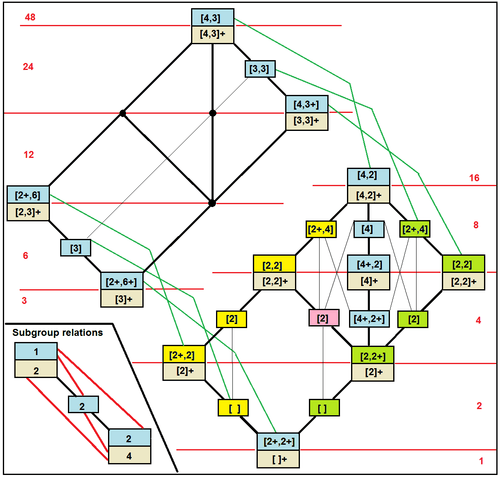 |
| Icosahedral symmetry | |
 |
| Finite (point groups in three dimensions) | |||||||||||||||||||||||||||||||||||||||||||||||||||||||||||||||||||||||||||||||||||||||||||||||||||||||||||||||||||||||||||||||||||||||||||||||||||||||||||||||||||
|---|---|---|---|---|---|---|---|---|---|---|---|---|---|---|---|---|---|---|---|---|---|---|---|---|---|---|---|---|---|---|---|---|---|---|---|---|---|---|---|---|---|---|---|---|---|---|---|---|---|---|---|---|---|---|---|---|---|---|---|---|---|---|---|---|---|---|---|---|---|---|---|---|---|---|---|---|---|---|---|---|---|---|---|---|---|---|---|---|---|---|---|---|---|---|---|---|---|---|---|---|---|---|---|---|---|---|---|---|---|---|---|---|---|---|---|---|---|---|---|---|---|---|---|---|---|---|---|---|---|---|---|---|---|---|---|---|---|---|---|---|---|---|---|---|---|---|---|---|---|---|---|---|---|---|---|---|---|---|---|---|---|---|---|
|
| ||||||||||||||||||||||||||||||||||||||||||||||||||||||||||||||||||||||||||||||||||||||||||||||||||||||||||||||||||||||||||||||||||||||||||||||||||||||||||||||||||
|
| ||||||||||||||||||||||||||||||||||||||||||||||||||||||||||||||||||||||||||||||||||||||||||||||||||||||||||||||||||||||||||||||||||||||||||||||||||||||||||||||||||
Subgroups
Given in Schönflies notation and Coxeter notation (orbifold notation), some low index point subgroups are:
| Reflection | Reflection subgroups |
Rotation subgroup | Mixed | Improper rotation | Commutator subgroup |
|---|---|---|---|---|---|
| C1v, [1]=[ ], |
C1, [1]+=[ ]+, |
S2, [2+,2+], |
[ ]+ | ||
| C2v, [2], |
[1+,2]=[1]=[ ], |
C2, [2]+, |
C2h, [2+,2], |
S4, [4+,2+], | |
| Cnv, [n], |
[1+,2n]=[n], |
Cn, [n]+, |
Cnh, [n+,2], |
S2n, [2n+,2+], |
[n]+, n odd [n/2]+, n even |
| Dnh, [2,n], |
[1+,2,n]=[1,n]=[n], |
Dn, [2,n]+, |
Dnd, [2+,2n], |
||
| Td, [3,3], |
T, [3,3]+, |
[3,3]+, (332) | |||
| Oh, [4,3], |
[1+,4,3]=[3,3], |
O, [4,3]+, |
Th, [3+,4], |
||
| Ih, [5,3], |
I, [5,3]+, |
[5,3]+, (532) |
Given in Coxeter notation (orbifold notation), some low index affine subgroups are:
| Reflective group |
Reflective subgroup |
Mixed subgroup |
Rotation subgroup |
Improper rotation/ translation |
Commutator subgroup |
|---|---|---|---|---|---|
| [4,4], (*442) | [1+,4,4], (*442) [4,1+,4], (*2222) [1+,4,4,1+], (*2222) |
[4+,4], (4*2) [(4,4,2+)], (2*22) [1+,4,1+,4], (2*22) |
[4,4]+, (442) [1+,4,4+], (442) [1+,4,1+4,1+], (2222) |
[4+,4+], (22×) | [4+,4+]+, (2222) |
| [6,3], (*632) | [1+,6,3] = [3[3]], (*333) | [3+,6], (3*3) | [6,3]+, (632) [1+,6,3+], (333) |
[1+,6,3+], (333) |
Rank four groups
 Subgroup relations |
Point groups
Rank four groups defined the 4-dimensional point groups:
|
|
|
|
|
Subgroups
| Order | Reflection | Semidirect subgroups |
Direct subgroups |
Commutator subgroup | ||||||
|---|---|---|---|---|---|---|---|---|---|---|
| 2 | [ ] | [ ]+ | [ ]+1 | [ ]+ | ||||||
| 4 | [2] | [2]+ | [2]+2 | |||||||
| 8 | [2,2] | [2+,2] | [2+,2+] | [2,2]+ | [2,2]+3 | |||||
| 16 | [2,2,2] | [2+,2,2] [(2,2)+,2] | [2+,2+,2] [(2,2)+,2+] [2+,2+,2+] | [2,2,2]+ [2+,2,2+] | [2,2,2]+4 | |||||
| [21,1,1] | [(2+)1,1,1] | |||||||||
| 2n | [n] | [n]+ | [n]+1 | [n]+ | ||||||
| 4n | [2n] | [2n]+ | [2n]+2 | |||||||
| 4n | [2,n] | [2,n+] | [2,n]+ | [2,n]+2 | ||||||
| 8n | [2,2n] | [2+,2n] | [2+,2n+] | [2,2n]+ | [2,2n]+3 | |||||
| 8n | [2,2,n] | [2+,2,n] [2,2,n+] | [2+,(2,n)+] | [2,2,n]+ [2+,2,n+] | [2,2,n]+3 | |||||
| 16n | [2,2,2n] | [2,2+,2n] | [2+,2+,2n] [2,2+,2n+] [(2,2)+,2n+] [2+,2+,2n+] | [2,2,2n]+ [2+,2n,2+] | [2,2,2n]+4 | |||||
| [2,2n,2] | [2+,2n+,2+] | |||||||||
| [2n,21,1] | [2n+,(2+)1,1] | |||||||||
| 24 | [3,3] | [3,3]+ | [3,3]+1 | [3,3]+ | ||||||
| 48 | [3,3,2] | [(3,3)+,2] | [3,3,2]+ | [3,3,2]+2 | ||||||
| 48 | [4,3] | [4,3+] | [4,3]+ | [4,3]+2 | ||||||
| 96 | [4,3,2] | [(4,3)+,2] [4,(3,2)+] | [4,3,2]+ | [4,3,2]+3 | ||||||
| [3,4,2] | [3,4,2+] [3+,4,2] | [(3,4)+,2+] | [3+,4,2+] | |||||||
| 120 | [5,3] | [5,3]+ | [5,3]+1 | [5,3]+ | ||||||
| 240 | [5,3,2] | [(5,3)+,2] | [5,3,2]+ | [5,3,2]+2 | ||||||
| 4pq | [p,2,q] | [p+,2,q] | [p,2,q]+ [p+,2,q+] | [p,2,q]+2 | [p+,2,q+] | |||||
| 8pq | [2p,2,q] | [2p,(2,q)+] | [2p+,(2,q)+] | [2p,2,q]+ | [2p,2,q]+3 | |||||
| 16pq | [2p,2,2q] | [2p,2+,2q] | [2p+,2+,2q] [2p+,2+,2q+] [(2p,(2,2q)+,2+)] | - |
[2p,2,2q]+ | [2p,2,2q]+4 | ||||
| 120 | [3,3,3] | [3,3,3]+ | [3,3,3]+1 | [3,3,3]+ | ||||||
| 192 | [31,1,1] | [31,1,1]+ | [31,1,1]+1 | [31,1,1]+ | ||||||
| 384 | [4,3,3] | [4,(3,3)+] | [4,3,3]+ | [4,3,3]+2 | ||||||
| 1152 | [3,4,3] | [3+,4,3] | [3,4,3]+ [3+,4,3+] | [3,4,3]+2 | [3+,4,3+] | |||||
| 14400 | [5,3,3] | [5,3,3]+ | [5,3,3]+1 | [5,3,3]+ | ||||||
Space groups
 Affine isomorphism and correspondences |
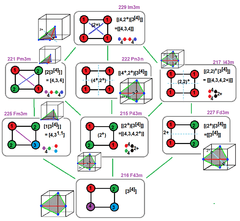 8 cubic space groups as extended symmetry from [3[4]], with square Coxeter diagrams and reflective fundamental domains |
 35 cubic space groups in International, Fibrifold notation, and Coxeter notation |
Rank four groups defined the 3-dimensional space groups include:
|
|
|
|
Line groups
Rank four groups also defined the 3-dimensional line groups:
| Point group | Line group | |||||||||
|---|---|---|---|---|---|---|---|---|---|---|
| Hermann-Mauguin | Schönflies | Hermann-Mauguin | Offset type | Wallpaper | Coxeter [∞h,2,pv] | |||||
| Even n | Odd n | Even n | Odd n | IUC | Orbifold | Diagram | ||||
| n | Cn | Pnq | Helical: q | p1 | o | [∞+,2,n+] | ||||
| 2n | n | S2n | P2n | Pn | None | p11g, pg(h) | ×× | [(∞,2)+,2n+] | ||
| n/m | 2n | Cnh | Pn/m | P2n | None | p11m, pm(h) | ** | [∞+,2,n] | ||
| 2n/m | C2nh | P2nn/m | Zigzag | c11m, cm(h) | *× | [∞+,2+,2n] | ||||
| nmm | nm | Cnv | Pnmm | Pnm | None | p1m1, pm(v) | ** | [∞,2,n+] | ||
| Pncc | Pnc | Planar reflection | p1g1, pg(v) | ×× | [∞+,(2,n)+] | |||||
| 2nmm | C2nv | P2nnmc | Zigzag | c1m1, cm(v) | *× | [∞,2+,2n+] | ||||
| n22 | n2 | Dn | Pnq22 | Pnq2 | Helical: q | p2 | 2222 | [∞,2,n]+ | ||
| 2n2m | nm | Dnd | P2n2m | Pnm | None | p2mg, pmg(h) | 22* | [(∞,2)+,2n] | ||
| P2n2c | Pnc | Planar reflection | p2gg, pgg | 22× | [+(∞,(2),2n)+] | |||||
| n/mmm | 2n2m | Dnh | Pn/mmm | P2n2m | None | p2mm, pmm | *2222 | [∞,2,n] | ||
| Pn/mcc | P2n2c | Planar reflection | p2mg, pmg(v) | 22* | [∞,(2,n)+] | |||||
| 2n/mmm | D2nh | P2nn/mcm | Zigzag | c2mm, cmm | 2*22 | [∞,2+,2n] | ||||
Duoprismatic group
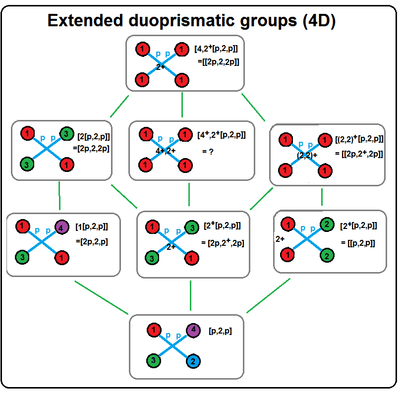
Rank four groups defined the 4-dimensional duoprismatic groups. In the limit as p and q go to infinity, they degenerate into 2 dimensions and the wallpaper groups.
| Wallpaper | Coxeter [p,2,q] |
Coxeter p,2,p |
Wallpaper | ||||
|---|---|---|---|---|---|---|---|
| IUC | Orbifold | Diagram | IUC | Orbifold | Diagram | ||
| p1 | o | [p+,2,q+] | [[p<sup>+</sup>,2,p<sup>+</sup>]] | p1 | o | | |
| pg | ×× | [(p,2)+,2q+] | - | ||||
| pm | ** | [p+,2,q] | - | ||||
| cm | *× | [2p+,2+,2q] | - | ||||
| p2 | 2222 | [p,2,q]+ | p,2,p+ | p4 | 442 | 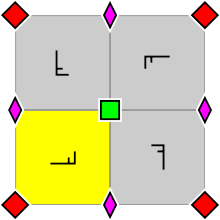 | |
| pmg | 22* | [(p,2)+,2q] | - | ||||
| pgg | 22× | [+(2p,(2),2q)+] | [[<sup>+</sup>(2p,(2),2p)<sup>+</sup>]] | cmm | 2*22 |  | |
| pmm | *2222 | [p,2,q] | p,2,p | p4m | *442 | 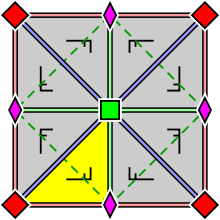 | |
| cmm | 2*22 | [2p,2+,2q] | [[2p,2<sup>+</sup>,2p]] | p4g | 4*2 |  | |
Wallpaper groups
Rank four groups also defined some of the 2-dimensional wallpaper groups, as limiting cases of the four-dimensional duoprism groups:
|
| |||||||||||||||||||||||||||||||||||||||||||||||||||||||||||||||||||||||||||||||||||||||||||
Subgroups of [∞,2,∞], (*2222) can be expressed down to its index 16 commutator subgroup:
| Reflective group |
Reflective subgroup |
Mixed subgroup |
Rotation subgroup |
Improper rotation/ translation |
Commutator subgroup |
|---|---|---|---|---|---|
| [∞,2,∞], (*2222) | [1+,∞,2,∞], (*2222) | [∞+,2,∞], (**) | [∞,2,∞]+, (2222) | [∞,2+,∞]+, (°) [∞+,2+,∞+], (°) [∞+,2,∞+], (°) [∞+,2+,∞], (*×) [(∞,2)+,∞+], (××) [+(∞,(2),∞)+], (22×) |
[(∞+,2+,∞+,2+)], (°) |
| [∞,2+,∞], (2*22) [(∞,2)+,∞], (22*) |
Notes
- ↑ Conway, 2003, p.46, Table 4.2 Chiral groups II
- ↑ Coxeter and Moser, 1980, Sec 9.5 Commutator subgroup, p. 124–126
- ↑ Norman W. Johnson, Asia Ivić Weiss, Quaternionic modular groups, Linear Algebra and its Applications, Volume 295, Issues 1–3, 1 July 1999, Pages 159–189
- ↑ The Crystallographic Space groups in Geometric algebra, D. Hestenes and J. Holt, Journal of Mathematical Physics. 48, 023514 (2007) (22 pages) PDF
References
- H.S.M. Coxeter:
- Kaleidoscopes: Selected Writings of H.S.M. Coxeter, editied by F. Arthur Sherk, Peter McMullen, Anthony C. Thompson, Asia Ivic Weiss, Wiley-Interscience Publication, 1995, ISBN 978-0-471-01003-6
- (Paper 22) H.S.M. Coxeter, Regular and Semi Regular Polytopes I, [Math. Zeit. 46 (1940) 380–407, MR 2,10]
- (Paper 23) H.S.M. Coxeter, Regular and Semi-Regular Polytopes II, [Math. Zeit. 188 (1985) 559–591]
- (Paper 24) H.S.M. Coxeter, Regular and Semi-Regular Polytopes III, [Math. Zeit. 200 (1988) 3–45]
- Kaleidoscopes: Selected Writings of H.S.M. Coxeter, editied by F. Arthur Sherk, Peter McMullen, Anthony C. Thompson, Asia Ivic Weiss, Wiley-Interscience Publication, 1995, ISBN 978-0-471-01003-6
- Coxeter, H. S. M. and Moser, W. O. J. (1980). Generators and Relations for Discrete Groups. New York: Springer-Verlag. ISBN 0-387-09212-9.
- Norman Johnson Uniform Polytopes, Manuscript (1991)
- N.W. Johnson: The Theory of Uniform Polytopes and Honeycombs, Ph.D. (1966)
- Norman W. Johnson and Asia Ivic Weiss Quadratic Integers and Coxeter Groups PDF Canad. J. Math. Vol. 51 (6), 1999 pp. 1307–1336
- N.W. Johnson: Geometries and Transformations, (2015) Chapter 11: Finite symmetry groups
- Conway, John Horton; Delgado Friedrichs, Olaf; Huson, Daniel H.; Thurston, William P. (2001), "On three-dimensional space groups", Beiträge zur Algebra und Geometrie. Contributions to Algebra and Geometry 42 (2): 475–507, ISSN 0138-4821, MR 1865535
- John H. Conway and Derek A. Smith, On Quaternions and Octonions, 2003, ISBN 978-1-56881-134-5
- The Symmetries of Things 2008, John H. Conway, Heidi Burgiel, Chaim Goodman-Strass, ISBN 978-1-56881-220-5 Ch.22 35 prime space groups, ch.25 184 composite space groups, ch.26 Higher still, 4D point groups



























![\left[{\begin{smallmatrix}1&0\\0&-1\\\end{smallmatrix}}\right]](../I/m/0ff3b4d384f25a00a3a29376d57badb8.png)
![\left[{\begin{smallmatrix}\cos 2\pi /p&\sin 2\pi /p\\\sin 2\pi /p&-\cos 2\pi /p\\\end{smallmatrix}}\right]](../I/m/8a614f32277dcbedd05c0bd902f6ce4f.png)
![\left[{\begin{smallmatrix}\cos 2\pi /p&\sin 2\pi /p\\-\sin 2\pi /p&\cos 2\pi /p\\\end{smallmatrix}}\right]](../I/m/9de4e4f818890766d2a72ad55cf7a55b.png)
![\left[{\begin{smallmatrix}1&0&0\\0&-1&0\\0&0&1\\\end{smallmatrix}}\right]](../I/m/1a9d78083e776bede3a327f7d1b6d690.png)
![\left[{\begin{smallmatrix}0&1&0\\1&0&0\\0&0&1\\\end{smallmatrix}}\right]](../I/m/59e461913ffde188eb6c99e74094b364.png)
![\left[{\begin{smallmatrix}-1&0&2\\0&1&0\\0&0&1\\\end{smallmatrix}}\right]](../I/m/8cdda909bbb1e74935873eb00cf6c92e.png)
![\left[{\begin{smallmatrix}0&1&0\\-1&0&0\\0&0&1\\\end{smallmatrix}}\right]](../I/m/34da88a89e24bc34a9c65b58d9a6ad30.png)
![\left[{\begin{smallmatrix}0&1&0\\-1&0&2\\0&0&1\\\end{smallmatrix}}\right]](../I/m/f2607c9abd1015c11a5646000f5e3a10.png)
![\left[{\begin{smallmatrix}-1&0&2\\0&-1&0\\0&0&1\\\end{smallmatrix}}\right]](../I/m/0bec5db1bab61c20504d6beba003da08.png)
![\left[{\begin{smallmatrix}0&1&0\\1&0&-2\\0&0&1\\\end{smallmatrix}}\right]](../I/m/672a945f7310e75254551e3a9c3a99c9.png)